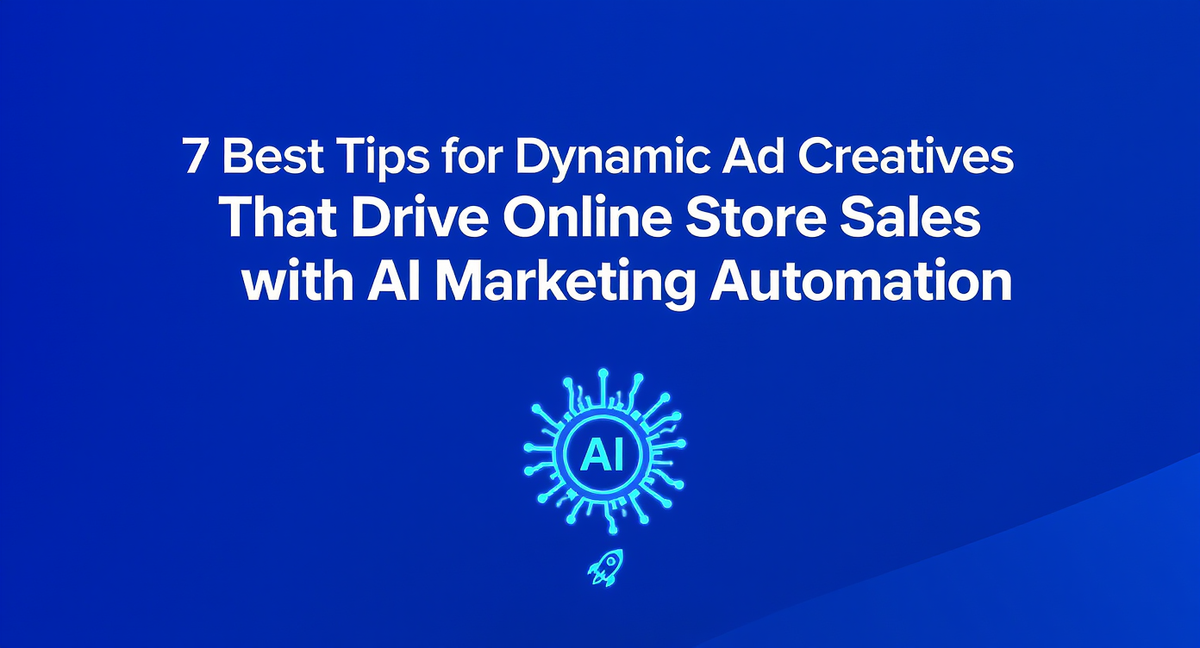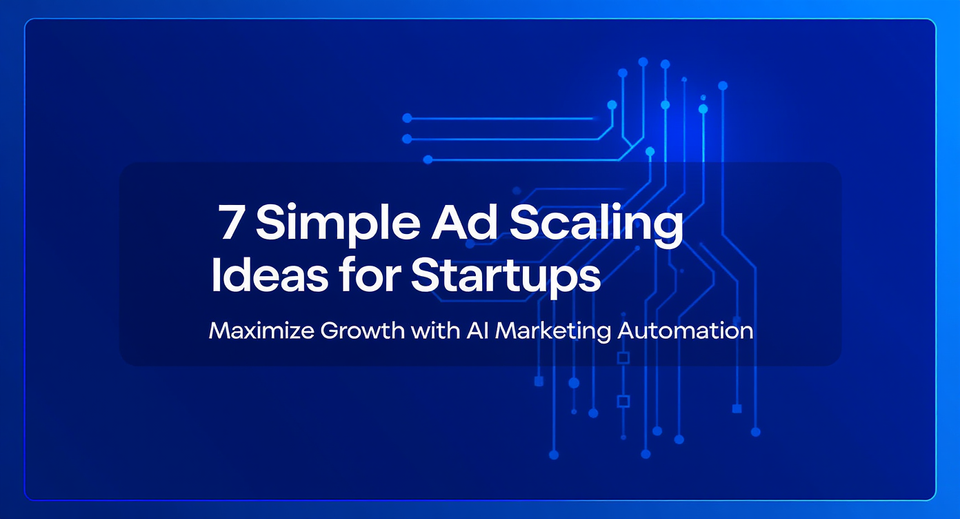7 Best Tips for Dynamic Ad Creatives That Drive Online Store Sales

In today's competitive online store world, static, one-size-fits-all ads no longer give the results they once did. Modern ad platforms like Meta, Google, and LinkedIn have moved from detailed audience targeting to machine learning algorithms that show ads based on creative relevance. This fundamental change means online stores must adjust their digital advertising approach.
Dynamic ad creatives—ads that automatically adjust their content based on user data, behavior, or context—have become essential for online store success. They allow personalization at scale without needing to manually create hundreds of ad variations. Let's explore seven best tips for using dynamic ad creatives that boost sales for online stores.
1. Use Creative as Your New Targeting Strategy
With privacy changes limiting traditional audience targeting, your creative elements now do the hard work in reaching the right customers. Instead of relying only on demographic filters, focus on developing creatives that speak directly to specific customer groups.
For example, instead of broadly targeting "women aged 25-34," create dynamic ads that showcase "Workout Gear for Busy Moms" or "Office Essentials for Remote Workers." This approach lets ad algorithms match your specific messaging to the right users based on their behavior and preferences.
SurgeGrowth's Creative-as-Targeting approach shows this shift, helping online store brands personalize creatives with specific messaging like "Fresh Summer Styles in Los Angeles" or "Winter Essentials for College Students" that naturally attract the right audience segments.

2. Build a Modular Creative Framework
Successful dynamic ad campaigns need a structured approach to creative development. Establish a modular framework where individual elements—headlines, images, CTAs, product displays—can be mixed and matched automatically.
This modular approach lets you:
- Create consistent brand experiences across many variations
- Test specific elements to find what works best
- Scale production without needing more design resources
- Maintain brand guidelines while allowing personalization
Start by identifying your core creative components (hero images, product shots, backgrounds, headlines, descriptions, CTAs) and create multiple versions of each that can be dynamically assembled based on user data or testing parameters.
3. Personalize Based on Customer Journey Stage
Different customers need different messaging depending on where they are in their buying journey. Dynamic ad creatives should adapt accordingly:
Awareness Stage: Focus on identifying problems and introducing your brand with broader messaging and educational content.
Consideration Stage: Highlight specific product benefits, comparisons, and social proof elements like reviews or user-generated content.
Decision Stage: Emphasize urgency, special offers, and clear calls-to-action that make it easy to buy.
Post-Purchase: Showcase complementary products, loyalty rewards, or referral incentives to encourage repeat business.
By mapping creative elements to these journey stages, your dynamic ads can automatically show the most relevant content based on a user's previous interactions with your brand.

4. Implement Smart Product Recommendations
For online stores, product recommendation engines are a powerful part of dynamic creative strategies. These systems can automatically choose which products to feature in ads based on:
- Browsing history and abandoned carts
- Previous purchases and complementary items
- Seasonal relevance and inventory levels
- Price points and promotional offers
- Trending or high-conversion products
When using product recommendations in dynamic ads, make sure you're collecting and using the right data signals. Set rules that prevent showing out-of-stock items or products with low profit margins during promotional periods.
5. Design for Multiple Ad Formats and Placements
Online store advertising covers many platforms, each with unique specifications and best practices. Your dynamic creative strategy should fit these differences automatically.
Create templates that can adapt to:
- Feed-based placements (Instagram, Facebook)
- Search and shopping ads (Google, Amazon)
- Video formats of varying lengths (YouTube, TikTok)
- Native placements (content sites, apps)
- Display networks and retargeting platforms
This multi-format approach ensures consistent messaging while optimizing for each platform's specific requirements and user behaviors. Tools like SurgeGrowth help online store brands automate creating hundreds or thousands of variations across different formats while maintaining design consistency and brand guidelines.
6. Establish Performance Feedback Loops
The real power of dynamic creative comes from constant optimization based on performance data. Implement systems that:
- Track performance metrics by creative elements combinations
- Identify winning patterns across audience segments
- Automatically move budget to high-performing variations
- Flag underperforming elements for revision or replacement
- Generate insights for future creative development
This closed-loop system makes sure your dynamic ads evolve based on actual performance rather than assumptions. Set up regular review cycles to analyze which creative elements drive the best results for different products, audiences, or goals.
7. Balance Automation with Brand Consistency
While scaling creative production through automation is essential, keeping brand consistency is equally important. Set rules that make sure all dynamic variations follow your brand standards:
- Create locked elements that stay the same across all variations
- Develop pre-approved messaging libraries for different products and groups
- Set limits for color usage, fonts, and visual hierarchy
- Implement approval workflows for new creative elements before they go live
- Regularly check generated ads to ensure quality and brand alignment
Implementing Dynamic Ad Creatives with SurgeGrowth
For online stores needing fast creative deployment, platforms like SurgeGrowth offer specialized tools that combine automated creative workflows with high-quality results. Their AI-powered platform helps brands launch thousands of personalized ad creatives efficiently while keeping brand consistency.
The platform's "Creative as Targeting" approach aligns perfectly with modern ad algorithms, allowing online store brands to create highly relevant ads for micro-segments based on location, audience type, intent, or behavior. This feature is especially valuable for businesses with a big product range, multiple locations, or diverse customer groups.
Conclusion
Dynamic ad creatives have evolved from a nice-to-have feature to an essential part of successful online store advertising strategies. By following these seven best tips, you can create personalized, relevant ad experiences that drive higher engagement and sales while reducing the workload on your marketing team.
The future of online store advertising lies in creative relevance, not just audience targeting. Brands that master dynamic creative production and optimization will gain a significant edge in capturing customer attention and driving growth.
Citations
- Meta reports that dynamic ads deliver 30-35% lower cost-per-conversion than static ads for online store advertisers. https://www.facebook.com/business/success/categories/dynamic-ads
- 80% of consumers are more likely to make a purchase when brands offer personalized experiences.
https://www.epsilon.com/us/about-us/pressroom/new-epsilon-research-indicates-80-of-consumers-are-more-likely-to-make-a-purchase-when-brands-offer-personalized-experiences - Dynamic creative optimization can improve conversion rates by up to 30% compared to standard creatives.
https://www.thinkwithgoogle.com/marketing-strategies/automation/dynamic-creative-optimization/ - Online store brands using dynamic product ads see an average of 12% higher click-through rates.
https://www.smartinsights.com/internet-advertising/internet-advertising-targeting/dynamic-creative-optimization/ - 71% of consumers expect companies to deliver personalized interactions, and 76% get frustrated when this doesn't happen. https://www.mckinsey.com/capabilities/growth-marketing-and-sales/our-insights/the-value-of-getting-personalization-right-or-wrong-is-multiplying
FAQs
Q: What are dynamic ad creatives?
A: Dynamic ad creatives are ads that automatically adjust their content (images, text, CTAs, etc.) based on user data, behavior, or context to provide more personalized and relevant experiences to potential customers.
Q: How do dynamic ad creatives benefit online stores?
A: Dynamic ad creatives help online stores increase conversion rates, reduce ad fatigue, personalize messaging at scale, test multiple creative elements at once, and optimize advertising spend across different products and customer groups.
Q: Do I need special tools to use dynamic ad creatives?
A: While basic dynamic ads can be created using native platform tools like Meta's Dynamic Ads, more advanced implementations typically need specialized platforms like SurgeGrowth that offer advanced creative automation, personalization, and optimization features.
Q: How many creative variations should I test in my dynamic ad campaigns?
A: The optimal number varies based on your audience size and campaign budget, but most successful online store advertisers test at least 3-5 variations of each creative element (headlines, images, CTAs) to gather meaningful performance data.
Q: How often should I update my dynamic ad creative elements?
A: Refresh your creative elements every 4-6 weeks to combat ad fatigue, but analyze performance data weekly to identify and replace underperforming elements sooner if necessary.




